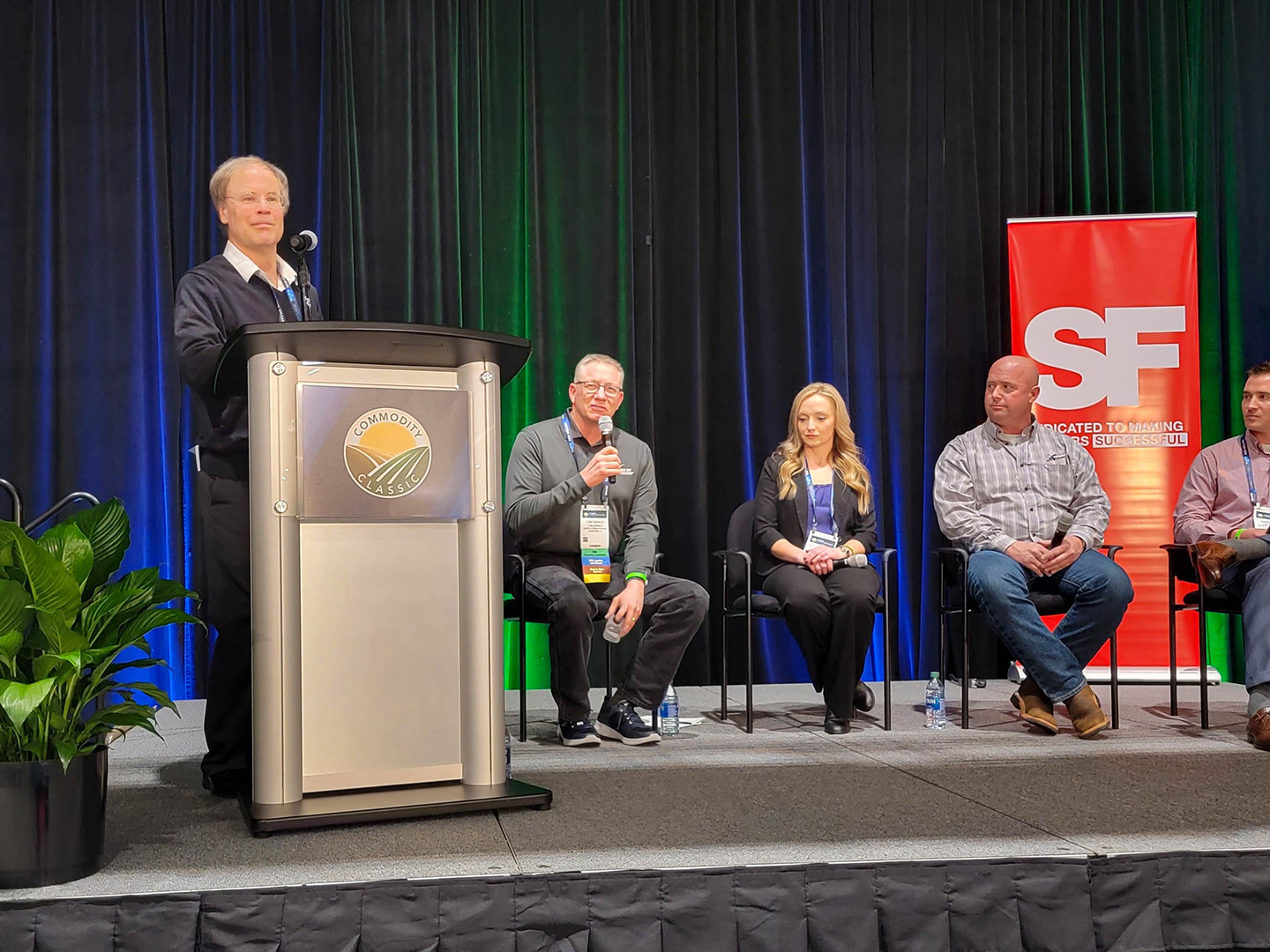
(Photo: Kriss Nelson/Iowa Soybean Association) Tom Oswald, United Soybean Board director and past Iowa Soybean Association president from Cleghorn speaks during a panel discussion on cashing in on carbon on Thursday at the Commodity Classic in New Orleans.
Could carbon be the next third crop?
March 11, 2022 | Kriss Nelson
Selling carbon credits could be a financial reward to practicing more environmentally friendly farming practices.
To discuss their personal opinions and experiences with selling carbon credits, two Iowa farmers took to the main stage during the Commodity Classic in New Orleans on Thursday.
Tom Oswald, United Soybean Board director and past Iowa Soybean Association (ISA) president from Cleghorn, and Kelly Garrett, ISA farmer-member from Arion, both agree practicing conservation is the right way to farm, however, they have different perspectives on cashing in on carbon.
“I am not convinced that is the place for my farm at this time,” says Oswald. “As you talk about the carbon market, I think there is more to learn. I believe it is so very important not to get caught up in the Wild West. Don’t follow the herd down the path to cash in on carbon credits.”
Oswald says he is apprehensive about how companies are measuring carbon.
“Right now, I can’t find what I call a consistent, reliable and possibly long-term measurement of carbon,” says Oswald, who incorporates no-till and strip-till practices on his farm. “Essentially, this is conducted commerce without the standard. To me, that is an excellent reason to wait. If I buy seed, it is so many thousands of seeds in a bag. If I buy a ton of fertilizer, I know it is a ton. I have yet to see, in the carbon markets, anything that has that level of substance.”
Garrett says carbon is measured in different ways. Some companies will soil test; others use an algorithm.
“They look at your practices, your yields, your rotation, your soil type and the algorithm tells them how much carbon is sequestered,” Garrett says. “It is different across different markets. As far as a standard, that doesn’t exist. I don’t want the government to be involved, but to get rid of the Wild West atmosphere and have a weights and standards measured, it is going to have to take government participation to make carbon markets adopt that.”
Cashing in
Garrett says he is 100 % no-till, and plants cover crops to help put as much carbon into the soil as he can.
“I believe that is the right way to farm. It’s the right way for my soil and being part of the carbon market is just a terrific bonus. It has added another revenue stream,” he says.
Garrett has been selling carbon credits to companies Nori and Truterra. He shared with the audience he received $75,000 on Dec. 1, 2020, for selling 5,000 carbon credits to Shopify. This sale, he claims, has given him the notoriety of the first farmer to sell carbon credits on the open market.
Never say never
Oswald says selling carbon credits might be in his future, but for right now, he is recommending fellow farmers to “lift their foot off the gas” and do their research first.
“Companies care about carbon,” Oswald says. “It is more important to me that farmers think about farming.”
Ultimately, Oswald wants the farmer to do what is best for their farm.
“Where do you want your farm to go? If it is about collecting cash, I don’t think that is sustainable. I hope your first part of it is – where do I want to take my farm,” Oswald says.
Oswald also prefers to look at his farm as a whole.
“I think carbon is a small piece of a much bigger sustainability picture of value proposition,” Oswald says. “Just because carbon is the shiny thing right now, think about it much bigger in this process. Of sustainability."
Who is truly reaping the benefits?
Oswald goes back to the Gold Rush.
“Think about that one. The service providers made the money. Very few miners made the money,” Oswald says.
For Garrett, he sees this as not only a financial opportunity for farmers but a way to buck the negativity thrown at the farming community.
“In the mainstream media, farmers are painted as the bad guy,” Garrett says. “I think this is the first time in my 25 years of farming we are being painted as the good guys. I want to be involved, and I want to keep promoting it.”
Back